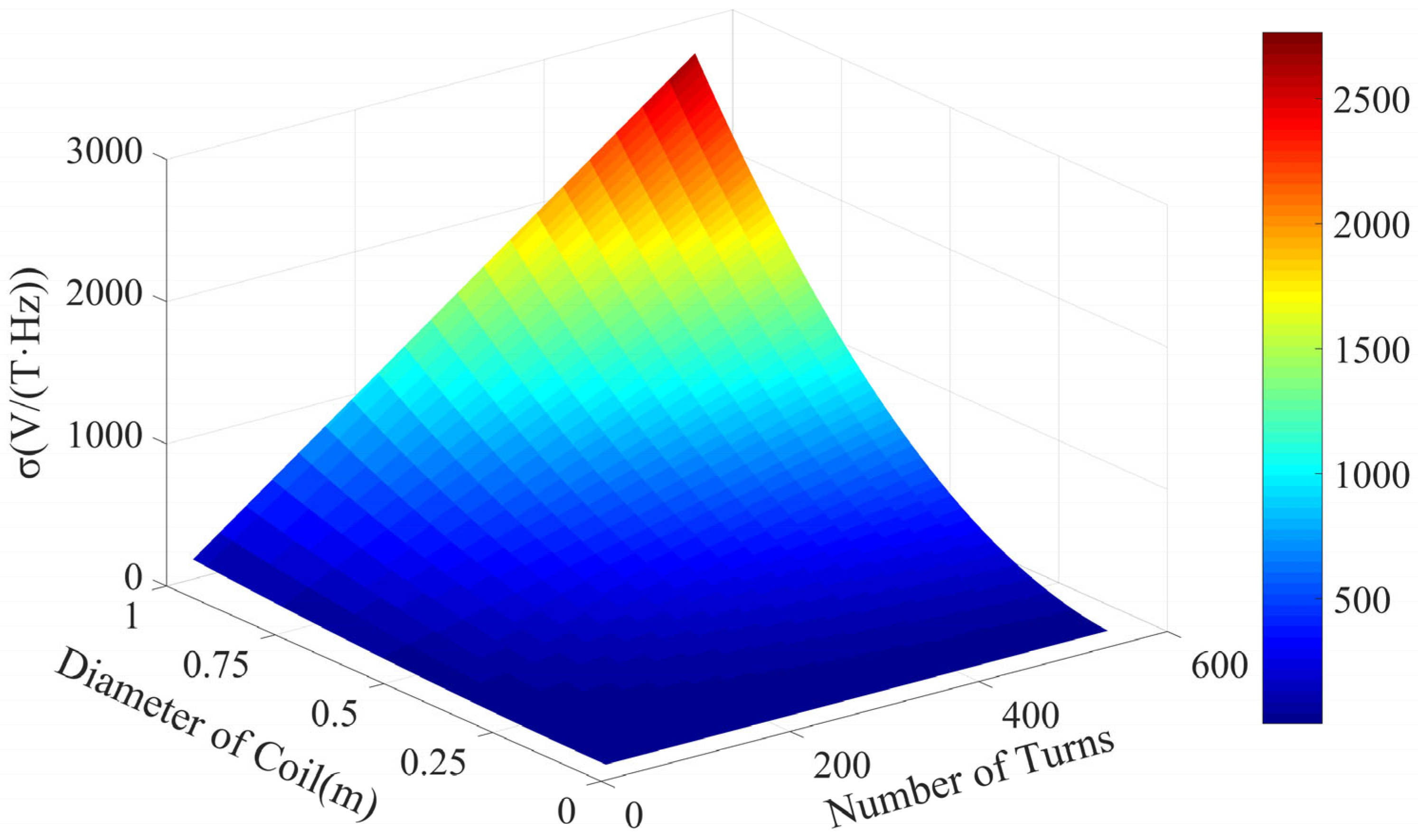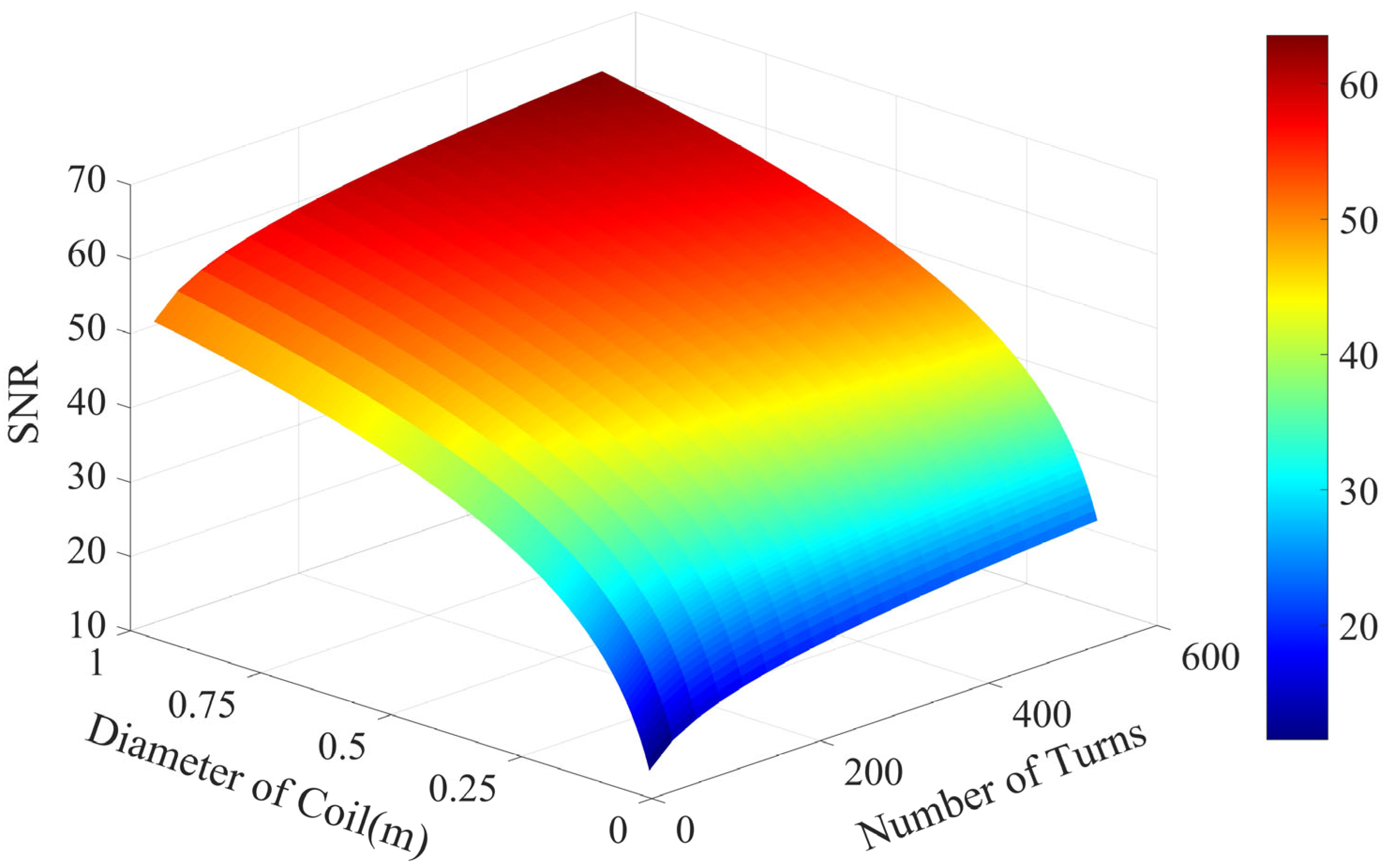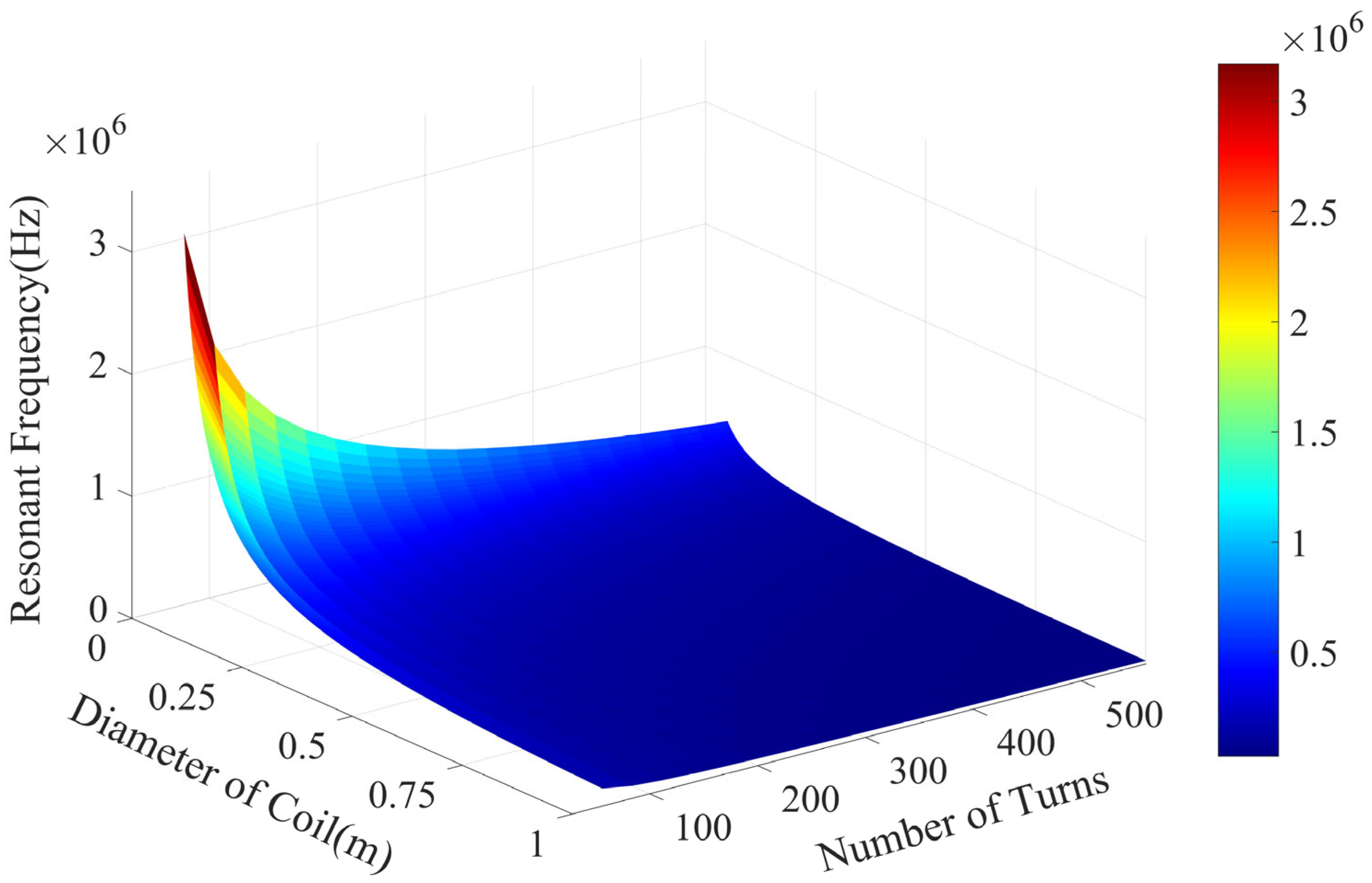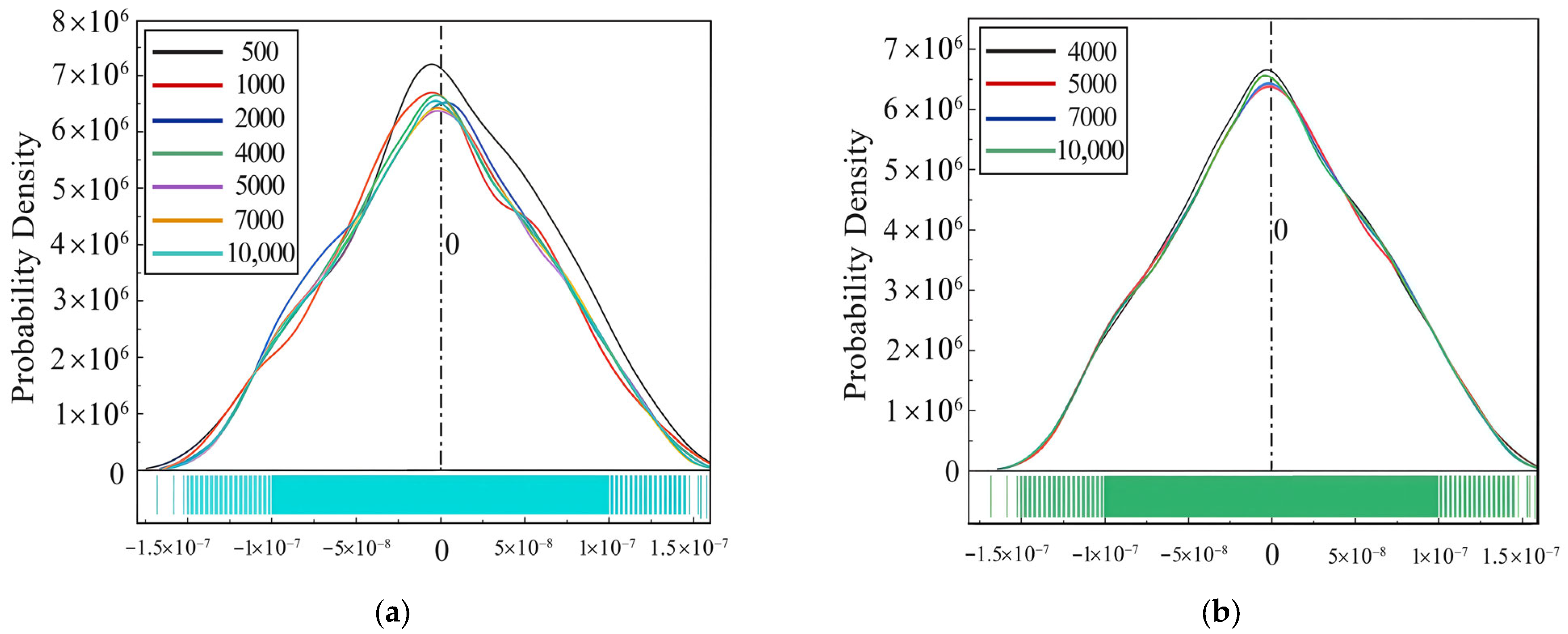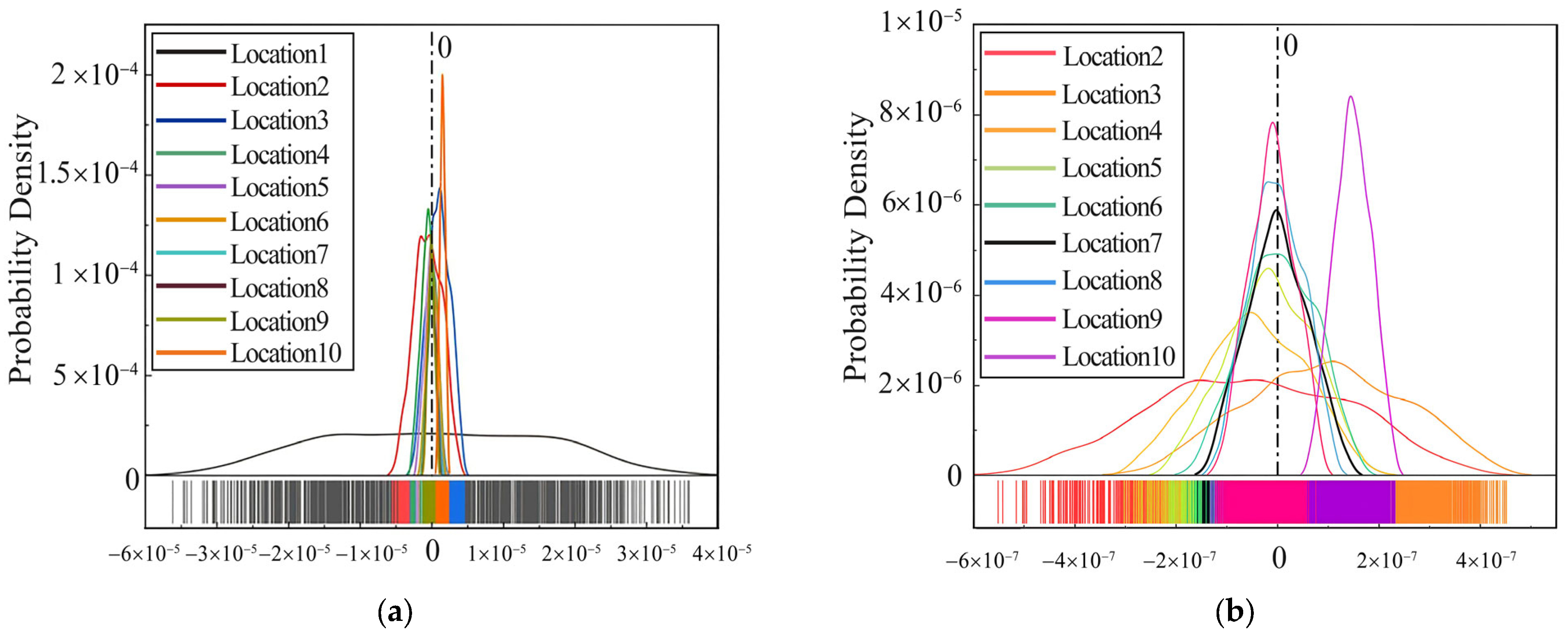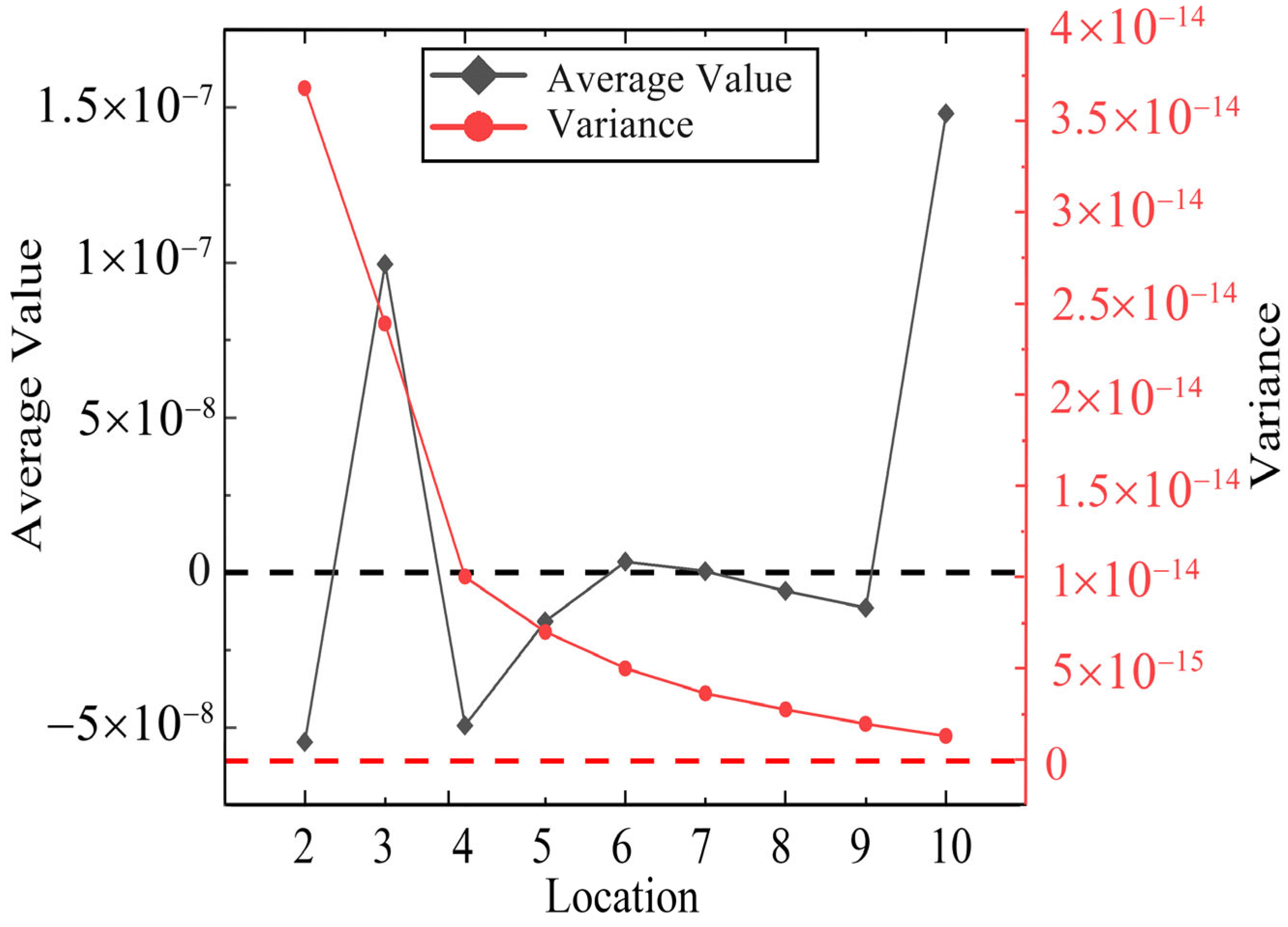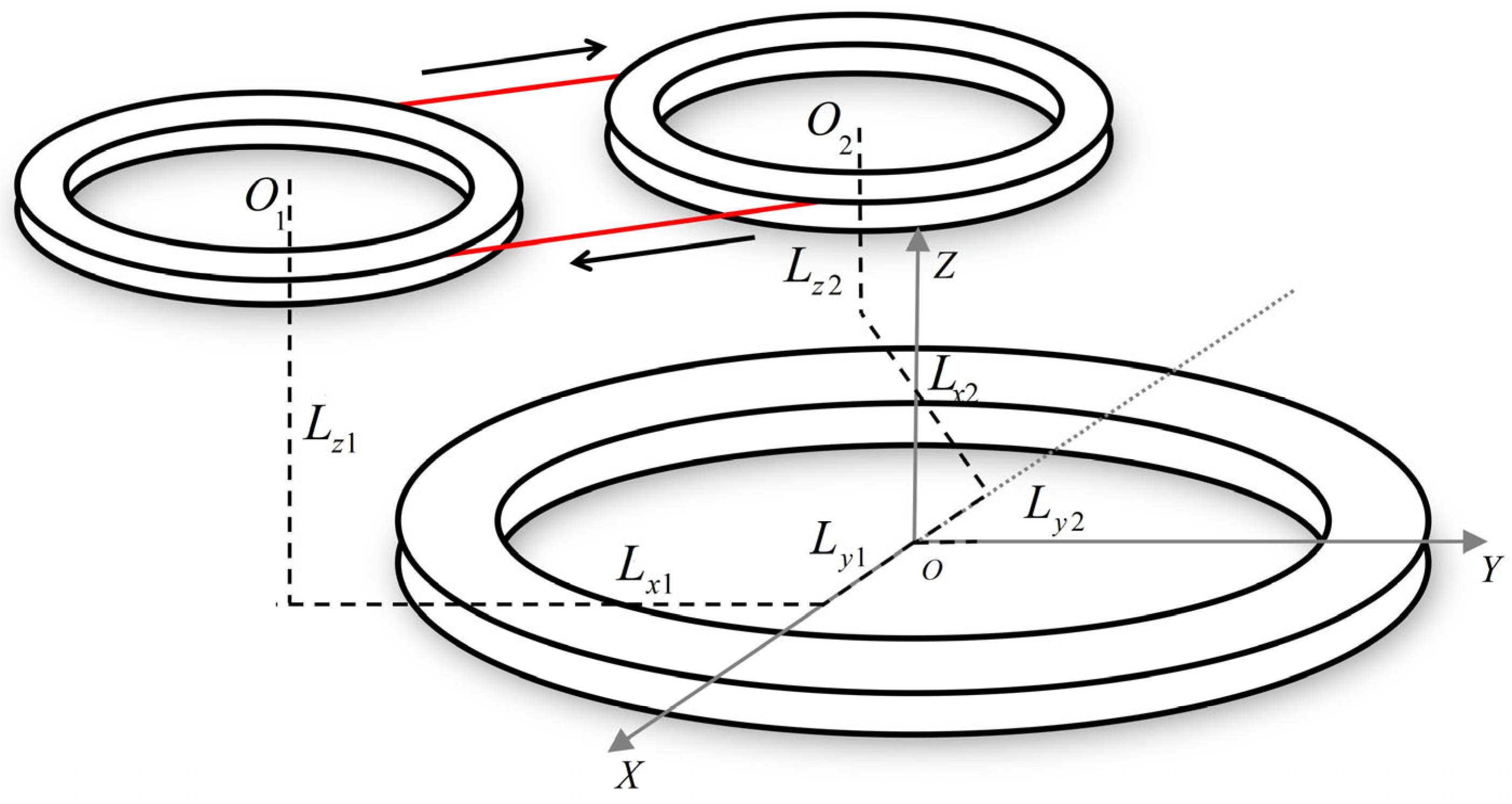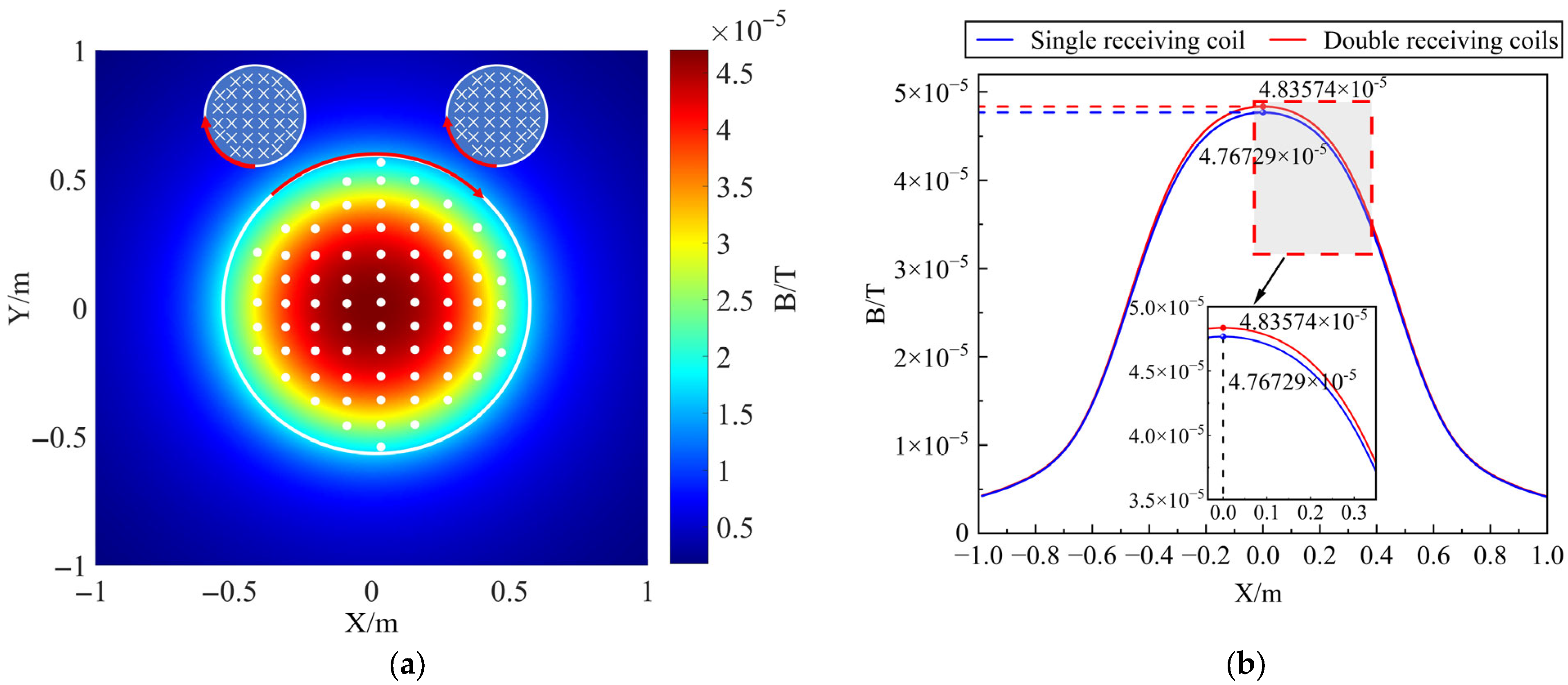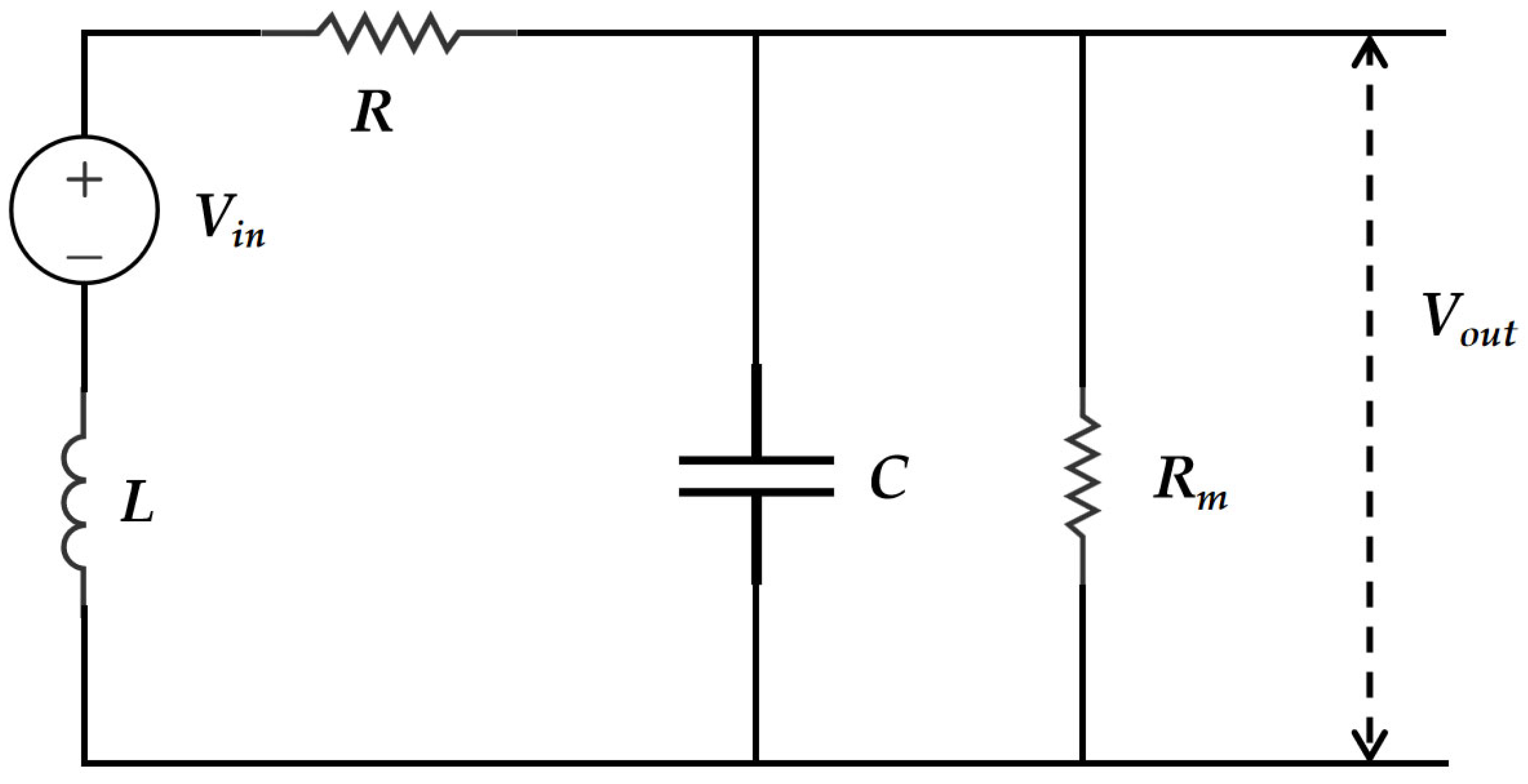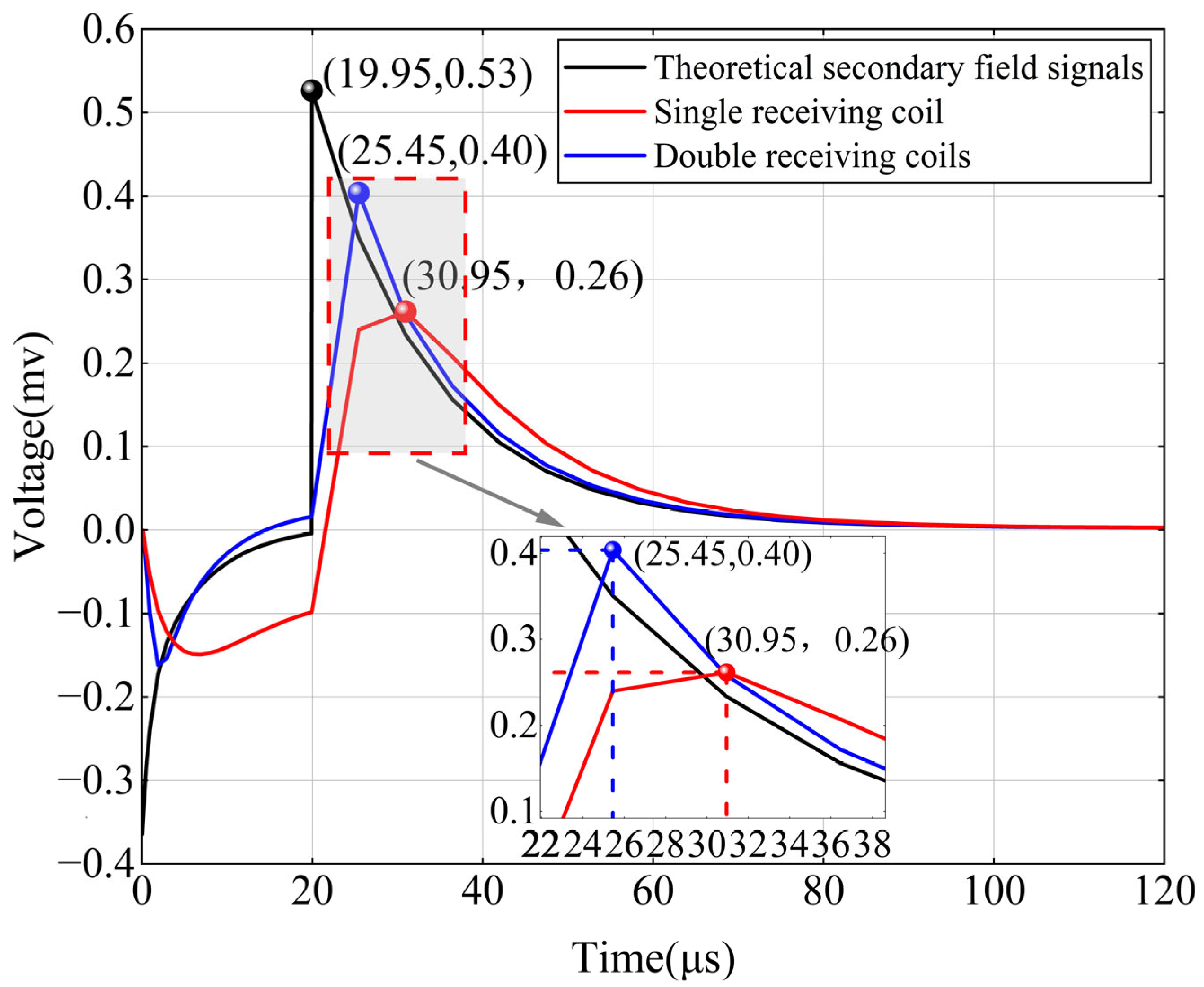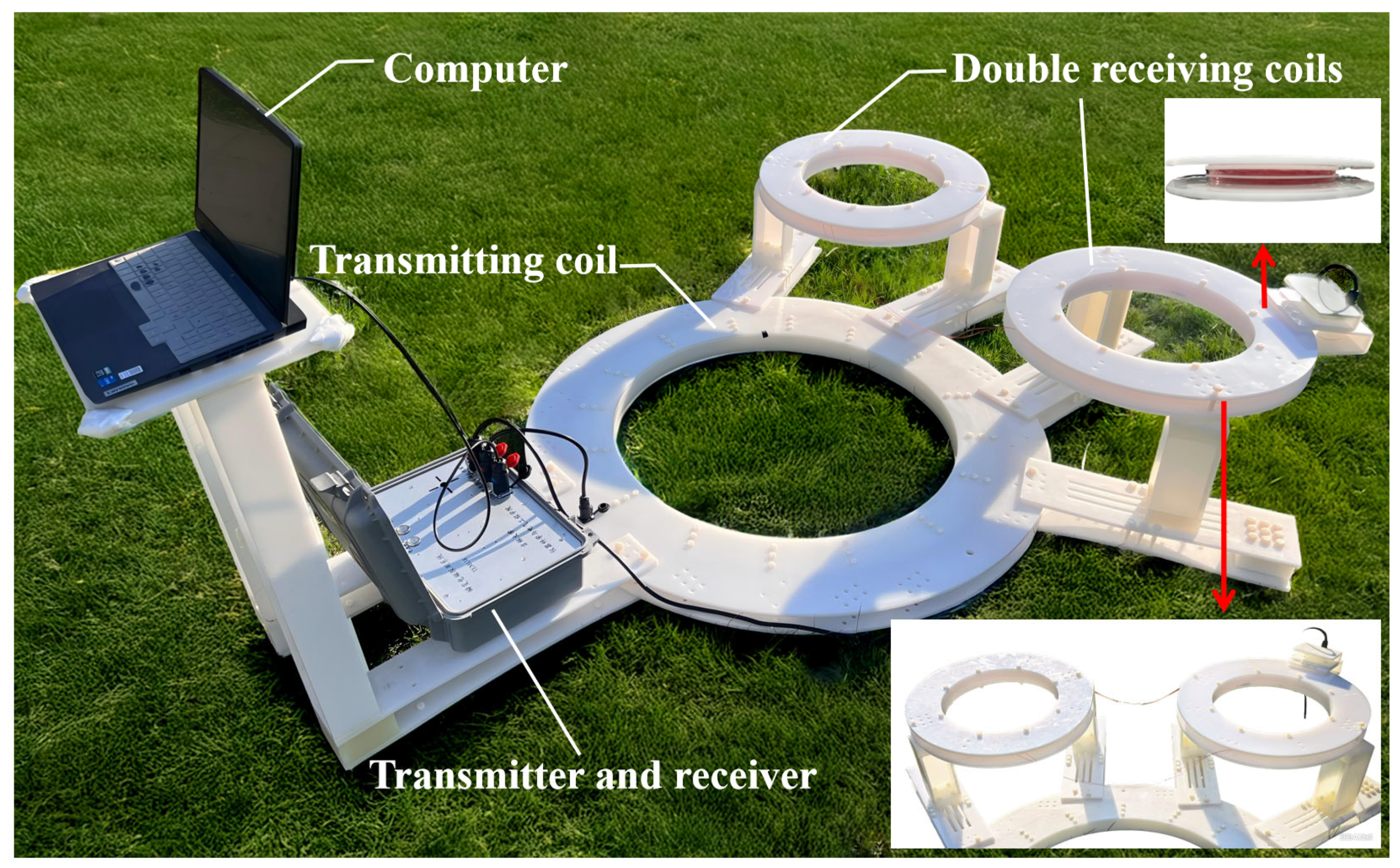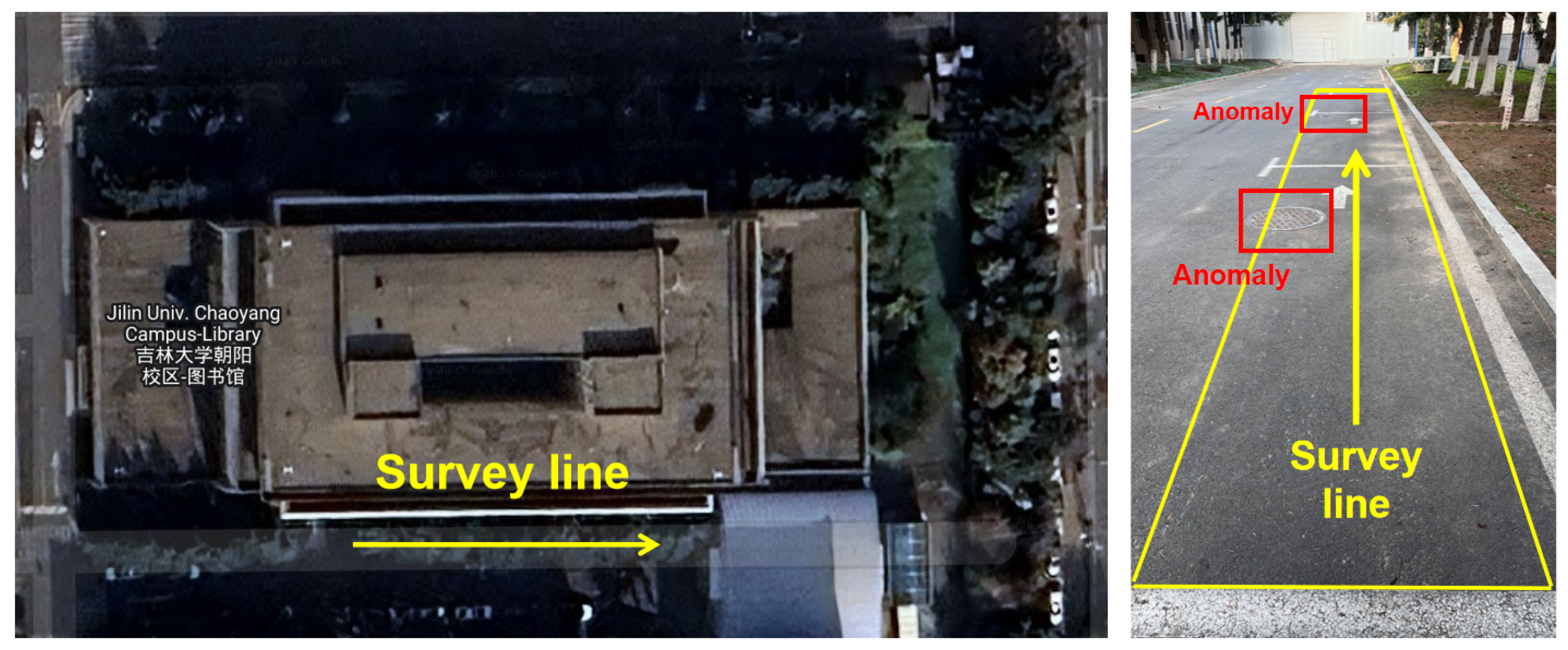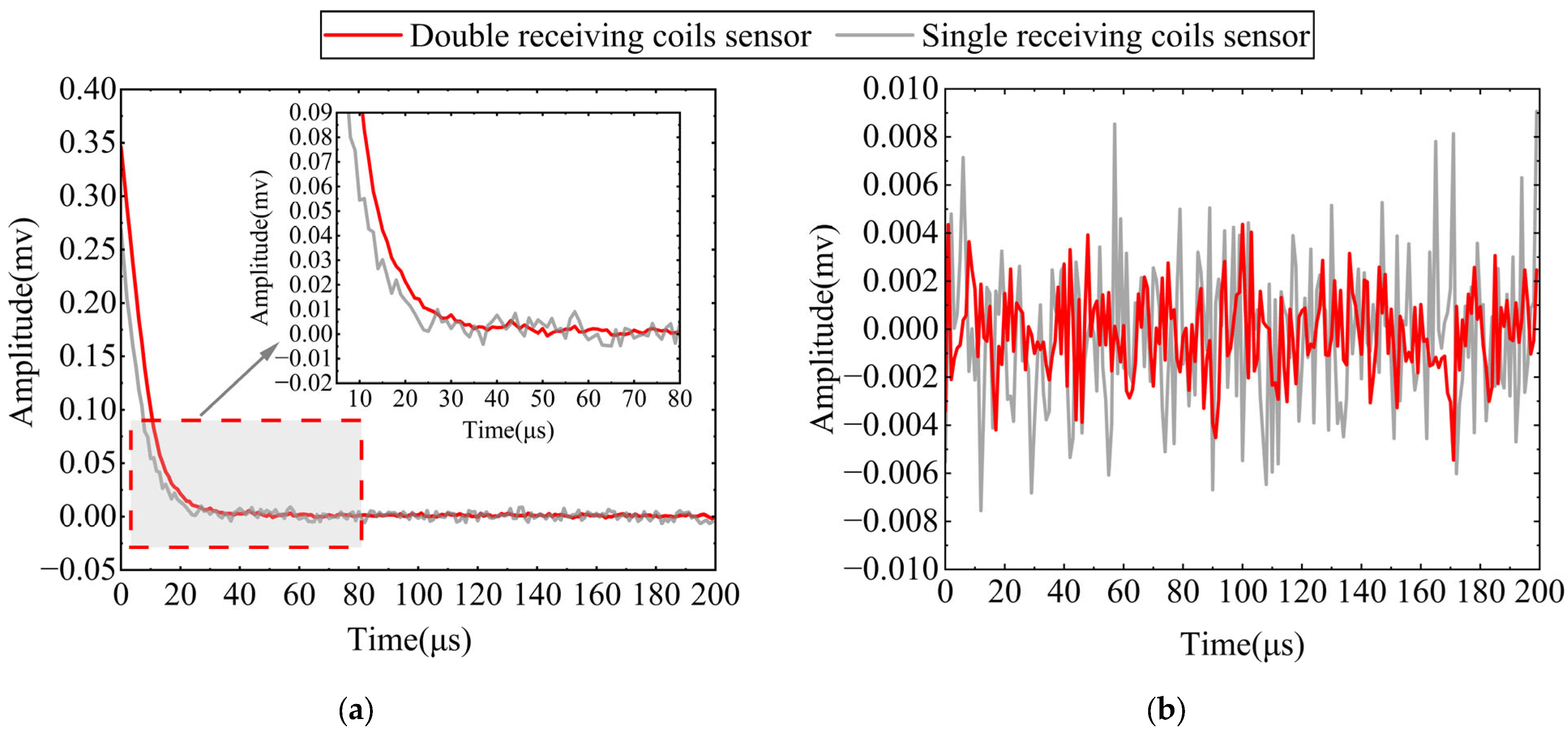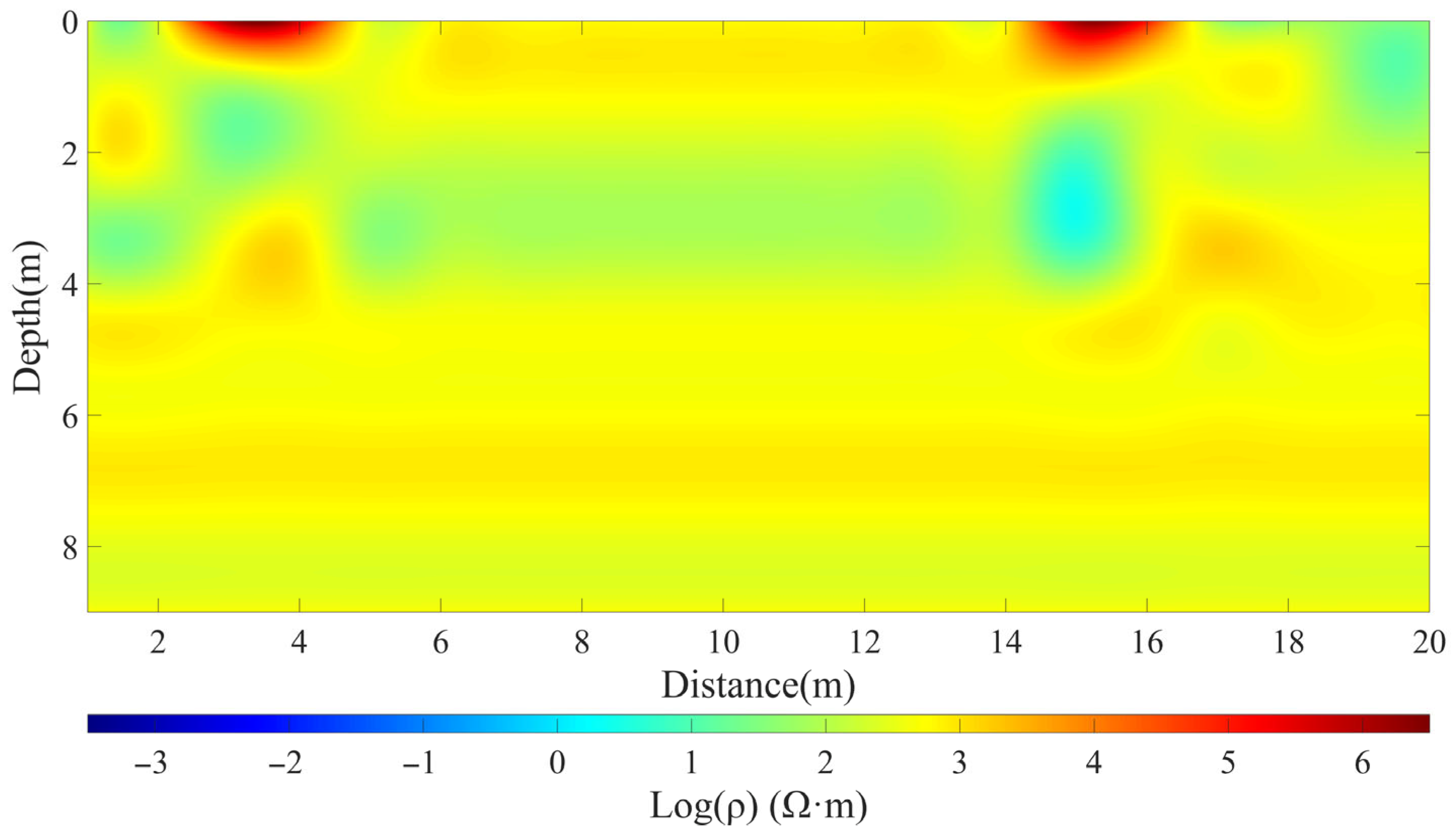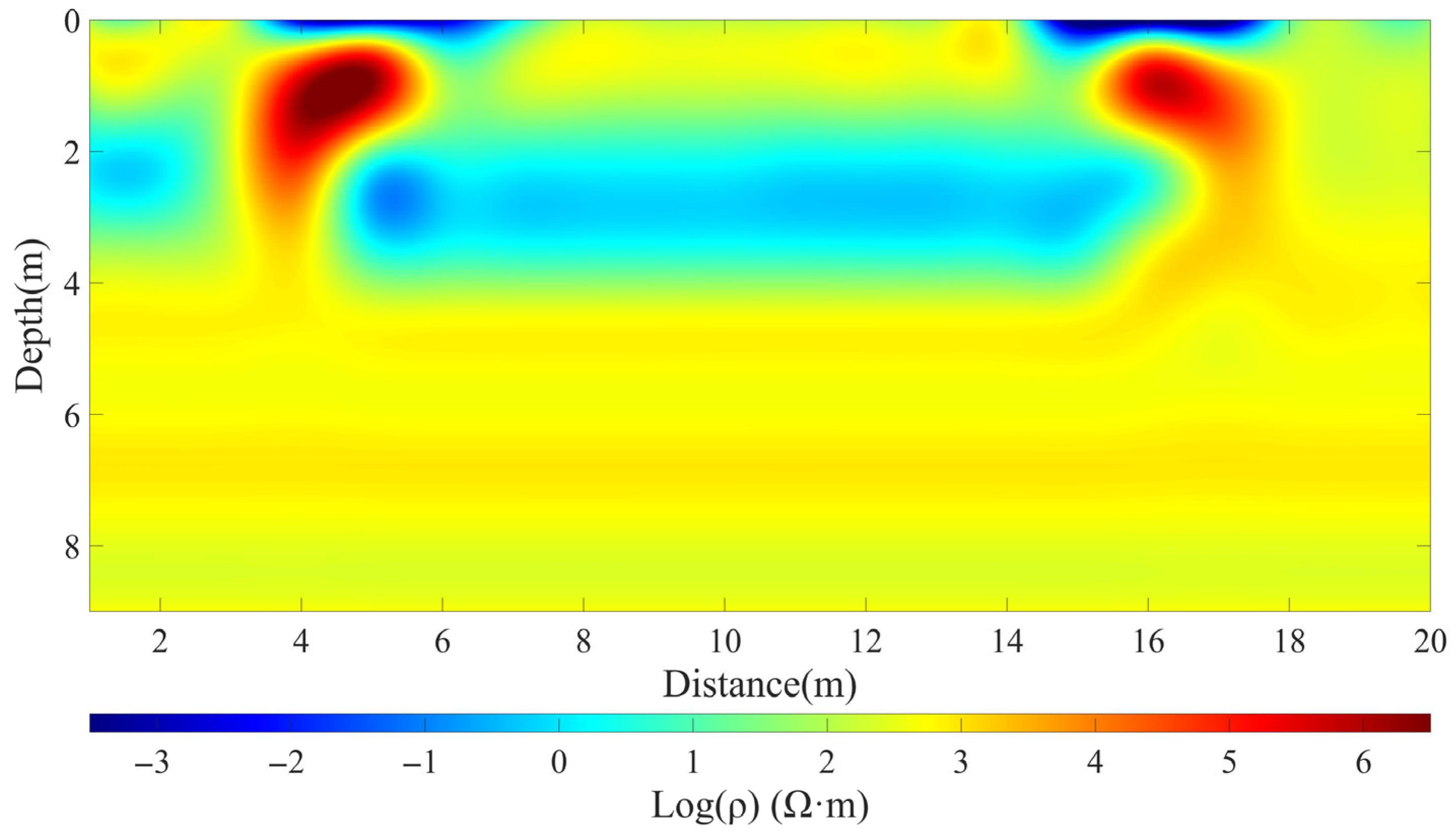2.1. Eccentric Coil Mutual Inductance Analysis
The transmitting and receiving coils are wound in a laminated structure. The center of the transmitting coil serves as a reference to establish a spatial right-angled coordinate system. The receiving coil is offset vertically and horizontally along the axis by a certain distance, and the central axes of the transmitting coil and the receiving coil are parallel to each other, and the numerical calculations for this structure are as follows:
According to Neumann’s formula, the mutual inductance coefficient between two single-turn coils is first considered. The mutual inductance
Mij between the coils is calculated by taking the
i-th turn of the transmitting coil
li, and the
j-th turn of the receiving coil
lj of any layer of transmitting and receiving coils in a cascaded structure. See the following example [
19]:
Considering the effects of the coil outer diameter, number of turns, laminated structure, and rotation angle, we calculated the mutual inductance between two coils when the center of the receiving coil is vertically offset by a distance
z relative to the center of the transmitting coil. We also calculated the positions where the mutual inductance is zero at different height planes to achieve zero coupling between the transmitting and receiving coil. The coordinates of the transmitting coil’s integrating line elements
li in Equation (1) are expressed as
xi,
yi, and
zi, while those of the receiving coil integrating line elements
lj are expressed as
xj,
yj,
zj, which can be represented as the following:
where
φi is the angle between the transmitting coil’s integral line element and the
y-axis direction, and
φj is the angle between the receiving coil’s integral line element and the
y-axis direction;
di is the vertical distance from the center of the wire diameter of the transmitting coil to the center of the whole transmitting coils, and
dj is the vertical distance from the center of the wire diameter of the receiving coil to the center of the whole receiving coil;
Lx,
Ly, and
Lz are the distances along each axis from the center of the receiving coil
lj relative to the origin of the spatial Cartesian coordinate system;
ri is the radius of a single-turn transmitting coil, accounting for the effect of layer thickness due to the transmitting coil wire diameter
eT;
rj is the radius of a single-turn receiving coil, accounting for the effect of layer thickness due to the receiving coil wire diameter
e;
D is the coordinate rotation matrix. See the following equation:
where
RT is the radius of the transmitting coil skeleton and
RR is the radius of the receiving coil skeleton;
ni and
nj are layer numbers in which the transmitting and receiving coils are located;
nT and
nR are the total number of layers of the transmitting and receiving coils, respectively;
α,
β, and
γ in the rotation matrix
D represent the angles of rotation of the
x-axis, the
y-axis, and the
z-axis of the plane where the receiving coil
lj is located, relative to the spatial right-angle coordinate system. Combining Equations (1)–(4), the mutual inductance
MTR of the transmitting and receiving coils of the eccentric structure is as follows:
where
NT and
NR are the total number of turns in the transmitting and receiving coils, respectively. In theory, because of the larger size of the receiving coil and the greater number of turns, the sensitivity will be higher. However, this also increases parasitic parameters and reduces the coil’s effective bandwidth. Therefore, before winding the coil, it is necessary to analyze its sensitivity, SNR, and resonance frequency to determine the number of turns and specific dimensions of the receiving coil.
Based on Faraday’s law of electromagnetic induction, the induced electromotive force generated on the receiving coil can be calculated by the following formula:
The peak value of the coil’s induced voltage is related to the number of the coil’s turns
nR and the coil diameter
DR. When analyzing sensitivity, the coil induction electromotive force is converted to the following form:
In the equation,
f is the frequency of change in magnetic induction intensity, with units of Hz. The equation clearly illustrates the relationship between the coil’s output voltage, the equivalent area of the coil, and the rate of change of the magnetic field intensity. To ensure the coil’s responsiveness to the magnetic field, the design of the coil’s structural parameters should be given priority. The sensitivity of the coil is as follows:
We analyze the mapping relationship between coil’s sensitivity and coil’s turns
nR and coil’s diameter
DR, as shown in
Figure 1. The main detection depth of the small-loop TEM device is the shallow layer several tens of meters below the ground surface. The secondary field characteristics generated at this depth are high frequency and large amplitude, so it is not necessary to use excessive sensitivity as a constraint.
- 2.
Receiving coil SNR analysis:
The noise generated by the coil itself is mainly thermal noise produced by the resistance of the conductor. Since the coil is the first stage in the signal acquisition process, excessive noise can significantly degrade signal quality. The DC internal resistance of the receiving coil is as follows:
In the equation,
ρR is the resistivity of the central conductor of the wire used, with units of Ω·m;
D is the diameter of the coil frame, with units of m;
dw is the diameter of the inner core of the wire, with units of m. Combining with Equation (9), the thermal noise
Vn of the receiving coil resistance is given by:
In the equation,
DR =
D +
hR, where
DR is the average diameter considering the stacking thickness of the coil layers,
hR is the stacking thickness of the wire,
kB is the Boltzmann constant with a value of 1.38 × 10
−23 W s/K, and T is the absolute temperature, with units of K. According to Equations (6) and (10), the SNR of the response signal, considering thermal noise from the coil’s internal resistance, can be calculated as follows:
At room temperature, the resistivity of the wire is determined. According to the Equation (11), when the wire diameter and winding method are fixed, the SNR of the coil is only related to the number of turns
nR and the average diameter of the coil
DR. To ensure the ability of the receiving coil sensor to capture signals, the rate of change of the magnetic field induction intensity is set to 1 nT/s. The relationship between the SNR and the number of turns and average coil diameter is calculated, as shown in
Figure 2. The resistivity of the wire used is
R = 2.35 × 10
−8 Ω·m, and the inner diameter of the wire is
dw = 0.66 × 10
−3 m. As can be clearly seen from the figure, increasing the number of turns or the average diameter of the coil both cause the thermal noise voltage to increase. However, overall, the SNR improves as the equivalent area increases.
- 3.
Receiving coil resonance frequency analysis:
The self-inductance and distributed capacitance of the coil produce inductive reactance and capacitive reactance, respectively. Under the influence of an AC signal, the coil exhibits pure resistive behavior, and resonance occurs when the inductive reactance and capacitive reactance cancel each other out. Therefore, the resonance frequency depends only on the self-inductance and distributed capacitance, and follows the relationship shown below:
Using an empirical formula that combines the coil’s self-inductance and distributed capacitance, with the relative dielectric constant
εp = 5 of the wire insulation film, the relative permittivity of the nylon skeleton
εn = 3, the thickness of the insulation layer between the wires
δ0 = 0.3 mm, the interlayer distance
δ1 = 0.5 mm, and the width between the skeleton slots
e = 4 mm, the relationship between the coil’s resonance frequency, the number of turns, and the average coil diameter is obtained, as shown in
Figure 3.
The coil’s resonance frequency corresponds to the sensor’s bandwidth. A wider bandwidth allows the sensor to capture a more complete signal. To enhance the shallow detection capability of the small-loop TEM, the coil sensor’s bandwidth must be greater than 100 kHz. Based on this analysis, the sensitivity and SNR of the coil are mutually constrained by the bandwidth. Considering the detection performance of the small-loop TEM for shallow layers, this paper selects 128 turns for the receiving coil with a radius of 0.2 m. Based on the principles of small-loop TEM and practical testing experience, while ensuring sufficient transmission magnetic moment and facilitating detection in narrow spaces, the transmitting coil is designed with 12 turns and a radius of 0.5 m.
Based on the analysis above, we developed simulation models to calculate the mutual inductance values between the transmitting and receiving coils. The radius of the transmitting coil
RT is set to 0.5 m, and the radius of the receiving coil
RR is set to 0.2 m; the number of turns of the transmitting coil
NT is 12, and the number of turns of the receiving coil
NR is 128; the wire diameter of the transmitting coil
eT is 4.4 × 10
−3 m, and the wire diameter of the receiving coil
eR is 0.66 × 10
−3 m. The center of the transmitting coil is taken as the origin, and the horizontal offset of the receiving coil
L is set to range from 0 to 1 m, with a sampling interval of 0.02 m; vertical offset
H ranges from 0 to 0.4 m, with a sampling interval of 0.01 m. A total of 2000 positional mutual inductance values were calculated. Using the sampling statistics method, we analyzed the 10 locations with the smallest mutual inductance values to assess robustness. The magnitudes and corresponding locations of these 10 mutual inductance values are presented in
Table 1.
2.2. Robustness Analysis Based on Statistical Methods
First, we determined the number of the sampling times
N. In the eccentric self-compensating structure described in
Section 2.1, there are 10 parameters: the number of turns of the two coils
RT and
RR; the outer diameters of the wires
eT and
eR; the angles of rotation
α,
β,
γ, and the three-direction offset distances of
Lx,
Ly, and
Lz. These parameters are sampled n times, generating random values following a normal distribution for the analysis. We selected position 7 (L = 0.76 m, H = 0.37 m), which was sampled 500 times, 1 k times, 2 k times, 4 k times, 5 k times, 7 k times, and 10 k times.
As shown in
Figure 4a, the probability density distributions of the seven experimental instances with sampling times of 500–10 k times are messy and irregular compared to each other, yet these are different upward and downward trends, and there is a large gap between the peaks. As shown in
Figure 4b, the upward and downward trends of the probability density distribution curves are almost identical with each other when the sampling times are more than 4 k times and there is not much difference between the peaks. To further verify this result, we used the Kolmogorov–Smirnov test which is a goodness-of-fit test to validate it two by two. The test results are shown in
Table 2.
Groups M, N, P, and Q represent the probability distributions of 4 k, 5 k, 7 k, and 10 k samples, respectively. The D-value is the maximum difference between the two empirical distribution functions, and the Z-value is the test statistic of the K-S test for the two samples. It can be found that the asymptotic probabilities > |D| between the two distributions are all close to 1, indicating that, at the 0.05 level, there is no significant difference among the four distributions. Therefore, considering computational efficiency and time constraints, the final number of samples for each group was set to be 4000.
Based on the number of samples, the mutual inductance was statistically calculated for 10 locations. The central parameters of the transient electromagnetic device were consistent with the model constructed in
Section 2.1. The remaining parameters are taken as follows:
The radius of the transmitting–receiving coil is represented by a 4000 × 1 matrix of random numbers following a normal distribution, with the theoretical radius as the mean and 0.003 m/3 as the standard deviation; The outer diameter of the transmitting–receiving coil wire is a 4000 × 1 matrix of random numbers following a normal distribution, with the theoretical outer diameter as the mean and the theoretical outer diameter value as the standard deviation. The angle of rotation of the transmitting coil around the
XY axis is a 4000 × 1 matrix of random numbers following a normal distribution with 0 as the mean and 5/360*2*pi/3 as the standard deviation; The
XZ axis offset distance of the receiving coil is a 4000 × 1 random array that follows a continuous uniform distribution of values taken in a closed interval of plus or minus 5 mm on the horizontal and vertical offsets of position “n”; The Y axis offset distance of the receiving coil is a 4000 × 1 random array that follows a continuous uniform distribution of values taken in a closed interval with 0 as the center amount plus or minus 5 m. Based on the parameters above, 4000 sets of mutual inductance values are obtained for each location, and their probability density distribution images are plotted, respectively, as shown in
Figure 5a. The probability density distribution of the data at location 1 obviously does not follow a normal distribution and differs significantly from other data sets. Therefore, only the data from locations 2 to 10 are analyzed and processed, as shown in
Figure 5b.
The mean and variance are calculated and compared, as shown in
Figure 6. Although location 10 has the smallest variance, its mean value is obviously too large and not close to zero. The variances at locations 2 to 6 are not ideal, and their mean values are not optimal. The mean and variance at locations 7, 8, and 9 are similar to each other, these mean values are close to zero, and the variances are very small. When no error is considered, the mean value and the mutual inductance coefficient at location 7 are theoretically the smallest. Additionally, since the closer the receiving coil is to the ground, the larger the amplitude of the secondary field voltage induced by the geoid; we thus select location 7 as the final relative position of the transmitting and receiving coils for the eccentricity self-compensation. Its horizontal offset is 0.76 m, and its vertical offset is 0.37 m.
